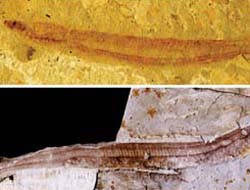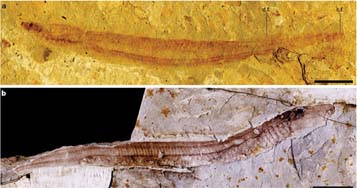

Mesomyzon mengae gen. et sp. nov. a, A complete fish (IVPPV14718A) in left view. b, Holotype (IVPP V14719) in right view.
The recent study on a new species of lamprey by a team headed by ZHANG Miman (Mee-Mann Chang) from the CAS Institute of Vertebrate Paleontology and Paleoanthropology (IVPP) has shed new light on the understanding of this primitive eel-like water-living creature. Their work was reported by a recent issue of
Nature.
With a history of more than 300 million years, the lamprey is one of the oldest aquatic vertebrates on the earth. However, its fossil remains are very rare and fragmentary. Only two important discoveries were made over the past 40 years or so. Both of them were found from the Carboniferous marine deposits in the United States. Unfortunately, all of them are not very well preserved and many of their morphological traits are difficult to identify.
Recently, together with ZHANG Jiangyong from IVPP and Miao Desui from University of Kansas, Zhang Miman carried out studies on well-preserved specimens unearthed from the Early Cretaceous strata of the lower Yixian Formation in Ningcheng County of China's Inner Mongolia, carrying the world-famous Jehol Biota.
Named as
Mesomyzon mengae after Prof. MENG Qingwen, a woman specialist devoting her lifelong time on study of Chinese fishes, the finding is believed to be a new genus and species of freshwater lampreys from the Early Cretaceous epoch (about 125 million years ago).
It is the first discovery from Mesozoic strata on the Euroasian landmass and in a freshwater ecosystem according to the experts. In addition, the specimens are in good state of preservation, many morphological features are kept intact. Furthermore, in comparison with their North American cousins, they were "younger" by nearly two hundred million years. They were living in fresh water and this fact explains that although lamprey had originated from a marine ecosystem at least 100 million years earlier, part of its offspring has been making their way off from the sea. In morphology, the new found species shares a lot of similarities with the extant species of the world today. This explains that during the past 100 million of years, its evolutionary speed is pretty slow, almost in a state of stagnation, known as "evolutionary stasis."
Experts say that the discovery further deepens our understanding of the lamprey in remote ancient times, fills the gap of fossil records in the Cretaceous period and enriches our knowledge about the lamprey's evolutionary history and its progressing speed.






